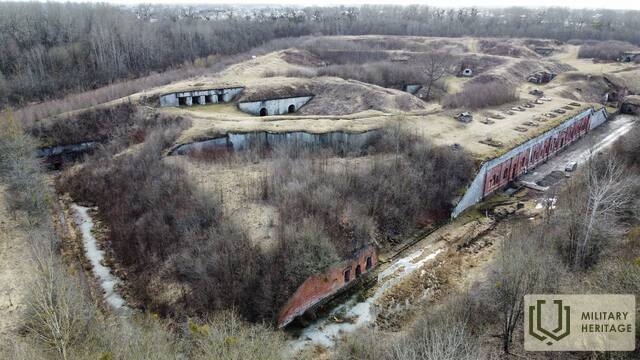Fort IV of Kaunas Fortress Fortification

Fort IV of the Kaunas Fortress in Rokusai, Kaunas city, was built in 1882–1889 and reconstructed in the late 19th century – early 20th century.
The fort has an asymmetrical plan, close to a triangle. It does not have a central postern crossing the territory. The buildings are arranged asymmetrically. There are barracks in the rear, between their buildings there is a gate - a rear caponier. In the front part - a central caponier, on the sides - two half-caponiers and additional intermediate half-caponiers. The outer ditch is surrounded by a counterscarp wall. When modernizing the fort in 1893, two four-story anti-assault cannon lifting casemates with a complex mechanism were designed and installed between the central ammunition depot and the central caponier by engineer Likhachev, allowing the cannons to be lifted immediately into firing positions. The left wing of the barracks, the phased ammunition depots, and posterns were reinforced with concrete. Unique concrete intermediate half-caponiers were built on the left and right flanks.
During the First World War, Fort IV covered the Second and part of the First defensive section with artillery fire. The main German attack was carried out in the First defensive section, so Fort IV and its crew could not make a significant impact on the defense of the fortress. After the Germans broke through the defense of the First defensive section, Fort IV received inaccurate information that Fort III was already occupied by the enemy, so the commandant of Fort IV was ordered to open artillery fire on the lost fort. The crew blew up the fort while retreating. The explosion destroyed the anti-assault cannon shelter and the ammunition depots were blocked.
During the interwar period, the army of Independent Lithuania used the fort for its own needs, the territory was intended for the training of students of the Military School, and was used as a training ground. During World War II, the Nazis used the territory of Fort IV as a place to kill Jews. During the occupation of Nazi Germany, about 4,000 Jews were killed in the fort. During the Soviet era, Fort IV was a military territory. For a long time, the fort was used as a warehouse and shooting range by the 108th Airborne Regiment.
In 1998–1999, Fort IV was cleaned and demined, but later the work stopped due to the cessation of funding. In 2012, the territory was cleaned again, but some of the spaces and premises remained blocked due to the damaged drainage system. Today, Fort IV is often home to contemporary art performances and practices.

















